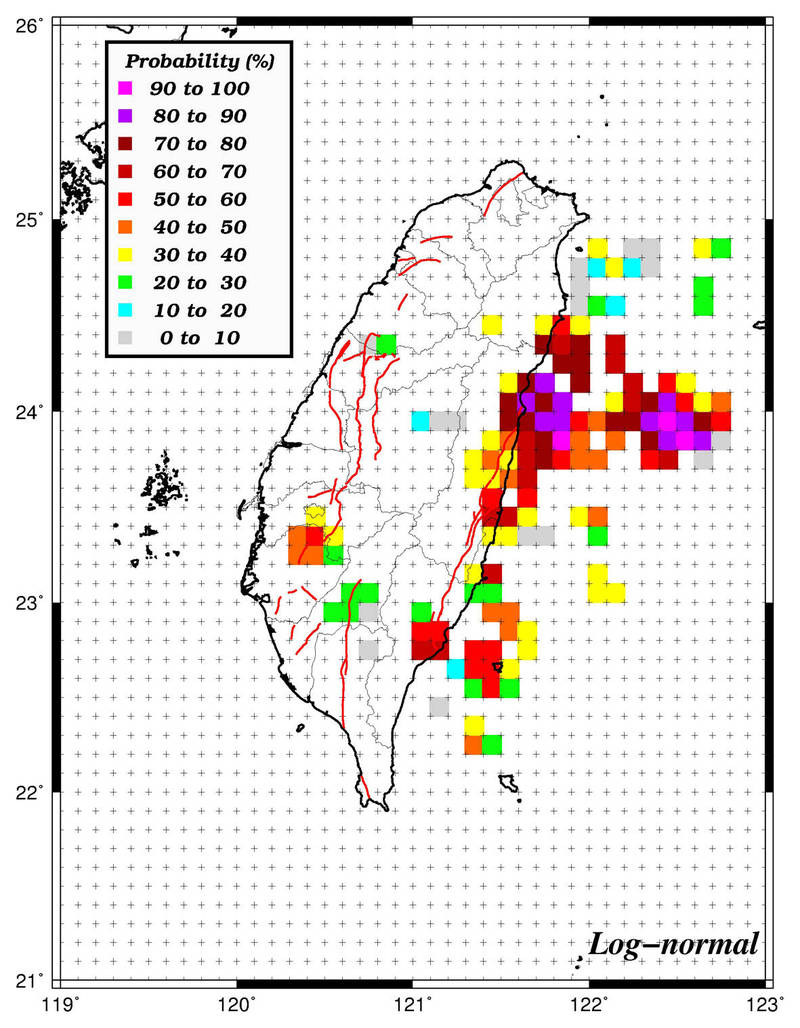《TAIPEI TIMES》High-risk faults lie beneath Chianan: CWB

A map compiled by the Central Weather Bureau shows the probability by area of a magnitude 6 or higher earthquake striking over the next 50 years. Photo courtesy of the Central Weather Bureau
By Chen Hsin-yu and Liu Tzu-hsuan / Staff reporter, with staff writer and CNA
There are three or four high-risk faults in the populous Chianan Plain (嘉南平原) beneath Chiayi County and Tainan, the Central Weather Bureau (CWB) said yesterday, declining to provide details to avoid causing panic.
About 10 faults of various lengths are in the area, but only three or four of them are considered dangerous, CWB Seismological Center Director Chen Kuo-chang (陳國昌) said.
As no dislocation has been recorded from the faults for a long time, their seismic activity should be monitored closely because the accumulated energy could be high, he said.
However, there is no ideal way of predicting earthquakes, and even calculating the long-term probability of a quake can be difficult, he said.
Former CWB director-general Shyn Tzay-chyn (辛在勤) told reporters at a news conference in Taipei that the Meishan (梅山), Chuko (觸口), Baihe (白河) and Sinhua (新化) faults in the Chianan Plain have long been considered potentially hazardous faults, and some seismologists believe that the Muchiliao (木屐寮) fault is a high-risk feature.
The risk levels of the faults have been known for nearly 50 years, but there was no reason to alarm people by discussing them, he said.
The latest research by the Central Geological Survey revealed 36 active faults nationwide, with seismologists warning about the Shanchiao fault (山腳斷層) beneath the Taipei basin.
Chen said that the risk of Shanchiao causing large earthquakes is quite low, adding that the fault has not caused earthquakes or rifts, or dislocated in the past century.
Some people are concerned that the Chishang fault (池上斷層) might dislocate, as the hypocenter of the main shock of Sunday’s magnitude 6.8 earthquake was near it.
“It is not certain” whether dislocation would occur, Chen said, adding that “only time will tell.”
Regarding this week’s series of earthquakes, Chen said that the temblors should gradually stop, with 164 earthquakes recorded as of 9:30am yesterday.
Aftershocks are expected to decrease in magnitude and frequency over the next four weeks, with a slim chance of a magnitude 5 quake today, he said.
The center has not yet identified an active fault linked to the quakes, the main shock of which was the strongest onshore earthquake to hit Taitung since 1973.
Since neither the main shock nor the foreshocks that reached magnitude 6 occurred along Chishang’s fault lines, it is certain that the quakes were not triggered by the Chishang fault system as some seismologists suggested, Chen said.
In response to speculation that the source of the quakes could be a blind active fault under the Central Mountain Range, Chen said no active fault line under the principal mountain range on Taiwan had been discovered, citing Central Geological Survey data from last year.
The survey would conduct further studies to determine if the Central Mountain Range fault is active but blind, which is still under debate in the seismology community, he added.
新聞來源:TAIPEI TIMES



















